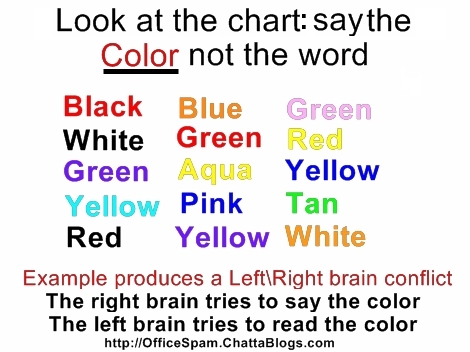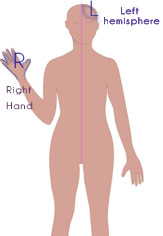Daniel Pink in "The Whole new Mind", "The two hemispheres of our brain don't operate as on-off switches- one powering down as soon as the other starts to light up- but we can say that certain regions of the brain are more active than others when it comes to certain functions"
|
"With more than three decades on research on the brain hemispheres, it's possible to distill the findings to four key differences: 1. The left hemisphere controls the right side of the body. The right hemisphere controls the left side of the body. 2a. The left hemisphere is sequential: it is specially good at recognizing events whose elements occur one after the other, also at coordinating serial functions, such as talking, understanding speech, reading and writing. |
2b. The right hemisphere is simultaneous: it's ability is to interpret things simultaneously and therefore grasping the big picture.
Seeing all the parts of a geometric form and grasping its form or seeing all elements in a situation and understanding what they mean.
This makes the right hemisphere particularly useful in interpreting faces with greatest advantage over the fastest supper computer.
It concentrates in the "present and the now". It has awareness of internal processes: It learns through kinesthesia and it uses body-input as information.
3. The left hemisphere specializes in text (language).
The right hemisphere specializes in context (integration).
4. The left brain analyzes the details; the right hemisphere synthesizes the big picture."
_Left side of brain
|
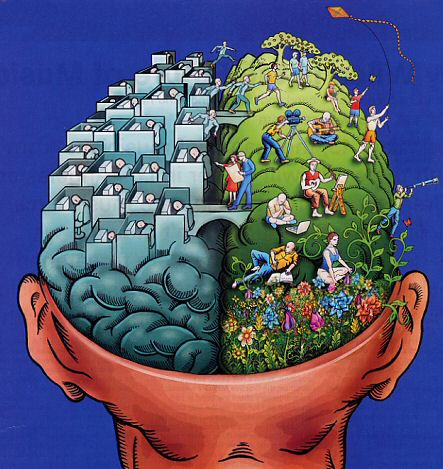 |
_Right side of brain
|
| Head see from Behind |
Roger Sperry, Nobel price in Physiology Medicine 1981 out of the "split brain" experiments produced since the 60s. Theory" Laterarization of the Brain", as specialization of each side.
http://www.nobelprize.org/educational/medicine/split-brain/background.html
Wikipedia on cerebral hemisphere. Notice that The strict scientific view (with literal and strict focus) does not support the "lateralization of the brain" theory, that requires a looser and more symbolic approach. Later brain research has demonstrated the "plasticity of the Brain" meaning the capacity of the tissue (neurons) to get rearranged in order to take over a different task. The lateralization of the brain is still a theory that explains human tendencies as thinkers, so it has a lot of valid points for us, dealing with human and image Pshychology.
http://en.wikipedia.org/wiki/Cerebral_hemisphere
Betty Edwards: "Drawing with the Right Side of the Brain", 1979. Changed the way drawing was taught. It also reveailed important facts about how we see and think about images.
http://www.amazon.com/Drawing-Right-Side-Brain-Definitive/dp/1585429201
Long lesson with her in YOUTube,
http://www.youtube.com/watch?v=ctkRwRDdajo
Creativity and Right brain development, http://www.ideachampions.com/weblogs/archives/2008/07/right_ways_of_w.shtm
Why Chinese is a language that implies a good grasp of right brain functions,http://www.transparent.com/chinese/left-brain-right-brain-middle-language-%E4%B8%AD%E6%96%87/
http://www.youtube.com/watch?v=UyyjU8fzEYU
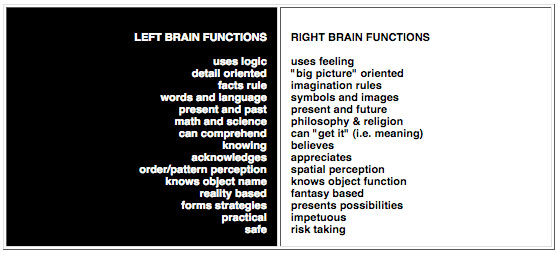
Author Daniel Pink.
Career analyst, former writer for Al Gore as a Vice-president, author of "The whole new Mind".
This is a very intelligent, witty and unusal man. A "jack of all trades". I like his powers of observation and capacity to relate and extract conclusions form data.
http://www.danpink.com/about
Daniel Pink is a better speaker than writer: we is entertaining and knows how to catch the attention of an audience. In fact, he directs thought in a very efficient way ( I almost see him as an standing comedian with a different type of content).
You can follow a video series of him talking in YOUTUBE.
Since this belongs t a series still for sale in DVD is difficult to find videos: Youtube puts them down once in a while.
Here is the latest I found (probably there because the name is spelled wrong):
you can always do a search for "Daniel Pink whole new Mind"
http://www.youtube.com/watch?v=CUDqN7MNsRw
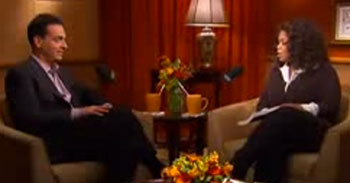
Look for this vintage video of Oprah Winfrey interviewing him about his (then) new book, The whole new mind.
Observe how Right-brain-oriented is Oprah, versus how analytical and to the point is Daniel, although he is trying to "dance to her song" given her enormous media-power (we also have to recognize her special charm).
Oprah Winfrey talks to Dan Pink about A Whole New Mind Part 1 from Daniel Pink on Vimeo. RECOMMENDED
Right hemisphere abilities:
|
Reasons for shift on necessary skills in the Western Economic system:
|
6 abilities that matter most:
|
"Humans are not ideally set up to understand logic; they are ideally set up to understand stories" Roger C. Schank, Cognitive scientist |
"The opposite of play isn't work. It's depression. To play is to act out and to be willful, exultant and committed as if one was assured of one's prospects" Brian Sutton-Smith |
"Aesthetics matter. Attractive things work better" Don Norman, Engineering professor |
Left versus Right brain conflict or the different ways of interpreting information
